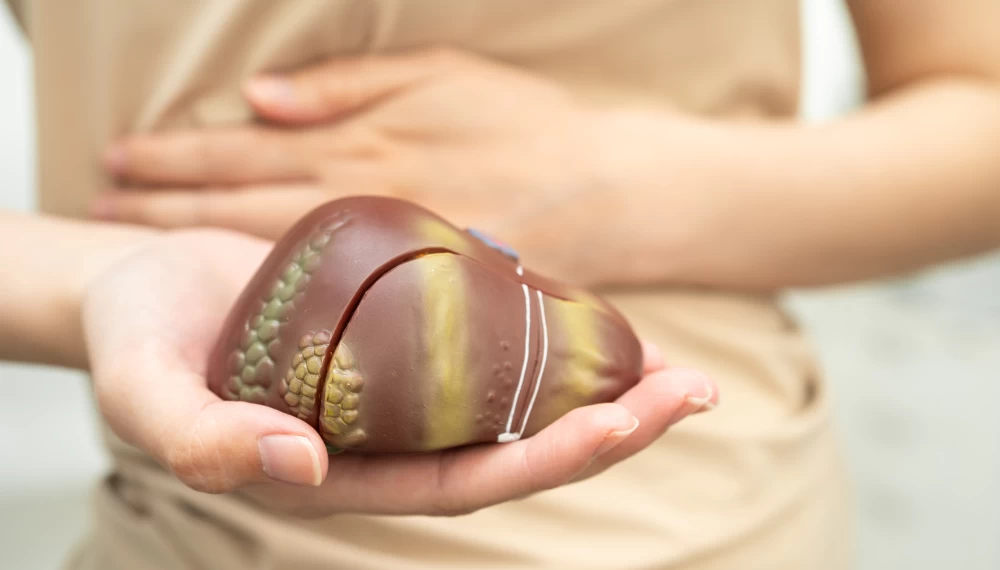
- 29th September 2025
Table of Contents
- What matters most in fatty liver
- Supplements people commonly use
- 1. Vitamin E (alpha‑tocopherol)
- 2. Omega‑3 polyunsaturated fatty acids (fish oil)
- 3. Silymarin (milk thistle)
- 4. Probiotics and prebiotics
- 5. Berberine, curcumin (turmeric extract), and other nutraceuticals
- 6. Vitamin D, N‑acetylcysteine, choline, and others
- Safety first: why supplements can be risky
- What to do instead of impulse buying
- Take‑Home messages
- Selected references
This article addresses adults worried about fatty liver who are taking or considering supplements marketed for “liver health.” It explains the evidence for common products, safety issues, and practical clinical guidance — written for clinicians and patients who want clear, no‑nonsense advice.
What matters most in fatty liver
Non‑alcoholic fatty liver disease (NAFLD) is a spectrum from simple steatosis (fat without inflammation) to non‑alcoholic steatohepatitis (NASH), fibrosis, and cirrhosis. The proven interventions that alter disease course are weight loss (5–10% body weight), control of metabolic risk factors (glucose, lipids), and — where indicated — specific drugs under specialist care. Supplements may offer small improvements in enzymes or imaging, but they do not replace diet, activity, and medical management. This is the essential context for any supplement discussion.
Supplements people commonly use
1. Vitamin E (alpha‑tocopherol)
Evidence: Vitamin E (800 IU/day) improved steatohepatitis histology versus placebo in the PIVENS randomized trial of nondiabetic adults with NASH, including reduced steatosis, inflammation, and ballooning. Benefits were seen in selected patients but not across all groups. Use is therefore targeted, not universal.
Risks & caveats: Long‑term high‑dose vitamin E may carry small risks (all‑cause mortality signal in some meta‑analyses, possible prostate cancer signal in older men). Always weigh risks vs benefit and limit use to patients who fit trial criteria or guideline recommendations.
2. Omega‑3 polyunsaturated fatty acids (fish oil)
Evidence: Multiple randomized trials and recent meta‑analyses show that omega‑3 fatty acids (eicosapentaenoic acid/docosahexaenoic acid) can reduce liver fat and improve triglycerides in NAFLD, though effects on inflammation and fibrosis are inconsistent. Benefits are usually modest and dose‑dependent.
Practical point: Omega‑3s help the lipid profile and may reduce steatosis; they are reasonable for patients with high triglycerides and NAFLD, but are not a la carte liver cure.
3. Silymarin (milk thistle)
Evidence: Trials of silymarin/silybin show mixed results — some small RCTs and meta‑analyses report improvements in liver enzymes and ultrasound‑based steatosis, while others are neutral. Larger, better‑quality trials are needed. Some recent systematic reviews find potential benefit but emphasise low certainty.
Risks & caveats: Generally well tolerated, but product quality varies. Herbal supplements can be mislabelled and occasionally hepatotoxic if contaminated. Use only third‑party tested brands and inform your clinician if you take them.
4. Probiotics and prebiotics
Evidence: Small trials suggest modulation of the gut microbiome can reduce liver enzymes and fat in NAFLD, but heterogeneity of strains, doses, and outcomes limits firm recommendations. Promising, but not standard care yet.
5. Berberine, curcumin (turmeric extract), and other nutraceuticals
Evidence: Early trials indicate improvements in transaminases, insulin resistance, or imaging endpoints for berberine and curcumin. Evidence is heterogeneous and mostly small. A recent position paper on nutraceuticals summarises potential mechanisms and limited clinical data — but stops short of routine recommendation.
6. Vitamin D, N‑acetylcysteine, choline, and others
These agents have plausible mechanisms and small trials but lack consistent, high‑quality evidence for routine use in NAFLD. Some (eg, choline deficiency) may help in selected patients, but blanket supplementation is not advised.
Safety first: why supplements can be risky
- Quality & contamination: Supplements are not regulated like medicines. Tests show mislabeling, variable active ingredients, and contamination with hepatotoxins in some herbal products.
- Drug interactions: Many herbal extracts interact with statins, anticoagulants, and other drugs — important in patients with metabolic syndrome who take multiple medications.
- Wrong target population: Supplements studied in biopsy‑proven NASH cannot be extrapolated to everyone with a fatty liver on ultrasound.
- Delay in effective treatment: Relying on supplements can delay weight loss interventions, glycemic control, and specialist referrals that truly change outcomes.
What to do instead of impulse buying
- Confirm the diagnosis and stage. Is it simple steatosis or NASH/fibrosis? Who needs specialist care? Use non‑invasive fibrosis tests (eg ,FIB‑4) and refer when indicated.
- Prioritise weight loss and metabolic control. A 5–10% weight loss reliably reduces liver fat and inflammation; manage diabetes, hypertension, and dyslipidemia aggressively.
- If considering a supplement, ask: Is there RCT evidence? Does the patient match trial inclusion criteria (eg, PIVENS criteria for vitamin E)? Are there safety concerns (age, comorbidity, interactions)?
- Choose quality brands & document use. Prefer third‑party tested products and record lot/brand in the chart. Stop supplements if no benefit after a pre‑specified period (eg, 6 months) or if adverse effects occur.
- Screen for hepatotoxic supplements. Ask about herbal products marketed as "liver cleanses"; some are hepatotoxic and should be stopped immediately.
Take‑Home messages
- Supplements are rarely a magic fix for fatty liver — lifestyle change and metabolic management are the treatment cornerstones.
- Vitamin E and omega‑3s have the best trial evidence in select patients but are not universally indicated.
- Herbal products (milk thistle, others) show mixed results; product quality and safety matter. Do not assume "natural" = safe.
- Discuss supplements with your clinician, choose tested brands if used, and prioritise interventions that change long‑term risk.
Selected references
- American Association for the Study of Liver Diseases (AASLD) Practice Guidance: Clinical assessment and management of NAFLD. 2023. (PMC)
- Sanyal AJ, et al. Pioglitazone, Vitamin E, or Placebo for Nonalcoholic Steatohepatitis (PIVENS). NEJM. 2010. (NEJM)
- Aziz T, et al. Systematic review/meta-analysis: Omega‑3 fatty acids in NAFLD. 2024–2025. (PubMed/PMC abstracts)
- Wang C, Li S, et al. Silymarin for treatment of adults with NAFLD: systematic review (2023).
- Rizzo M, et al. Nutraceutical approaches to NAFLD: Position Paper (2023).
